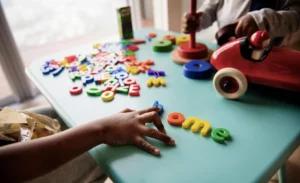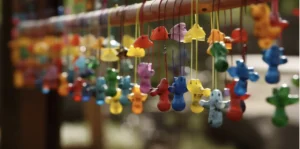The Rising Toy Manufacturing Industry in India: Trends and Opportunities
The toy manufacturing industry in India has witnessed significant growth and transformation in recent years. From traditional wooden toys to high-tech interactive gadgets, the sector has evolved to meet the changing demands of consumers. In this blog, we will delve into the current landscape of the toy manufacturing industry in India, highlighting key trends and opportunities that shape its future trajectory.

Current Status and Size of the Indian Toy Market:
The Indian toy market is experiencing robust growth, fueled by factors such as rising disposable incomes, changing lifestyles, and increasing awareness about the importance of play in child development. According to recent reports, the Indian toy market is valued at approximately $1.5 billion and is expected to grow at a compound annual growth rate (CAGR) of 12% in the coming years. Despite its sizable market, India’s per capita spending on toys remains relatively low compared to global standards, indicating significant untapped potential for growth.
Emerging Trends in Toy Manufacturing:
Emphasis on Educational and STEM-based Toys: In line with global trends, there is a rising demand for educational and STEM (Science, Technology, Engineering, and Mathematics) toys in India. Parents are increasingly seeking toys that not only entertain but also stimulate learning and creativity in their children. As a result, manufacturers are focusing on developing toys that promote problem-solving skills, critical thinking, and hands-on learning experiences.
Shift towards Eco-friendly and Sustainable Toy Production: With growing concerns about environmental sustainability, there is a notable shift towards eco-friendly and sustainable toy production in India. Manufacturers are increasingly using biodegradable materials, such as bamboo, recycled plastic, and organic cotton, to reduce the environmental impact of toy manufacturing processes.
Adoption of Technology in Toy Design and Manufacturing Processes: Technology has become a game-changer in the toy manufacturing industry, revolutionizing design, production, and distribution processes. Advanced technologies such as 3D printing, augmented reality (AR), and Internet of Things (IoT) are being integrated into toy design, enabling innovative features and interactive experiences for children. Additionally, digital platforms are being leveraged for marketing, sales, and customer engagement, providing manufacturers with new avenues for reaching their target audience.
In the subsequent sections of this blog, we will explore these trends in greater detail, examining their implications for manufacturers, consumers, and the overall toy ecosystem in India. Stay tuned for insights into the challenges, opportunities, and future prospects of the toy manufacturing industry in India.
Opportunities for Innovation and Growth:
Market Niches and Untapped Segments: The Indian toy industry offers various untapped segments and niche markets that present opportunities for innovation and growth. For instance, there is a growing demand for culturally relevant and region-specific toys that cater to diverse Indian traditions, languages, and folklore. Manufacturers can explore these niche markets to differentiate their offerings and capture niche consumer segments.
Potential for Export-oriented Manufacturing: India’s toy manufacturing sector has significant potential for export-oriented growth, leveraging its skilled workforce, competitive labor costs, and strategic geographical location. By focusing on quality, innovation, and compliance with international standards, Indian toy manufacturers can tap into global markets and expand their presence beyond domestic borders.
Government Initiatives and Policies: The Indian government has launched several initiatives and policies to support the growth of the toy manufacturing sector. Initiatives like ‘Make in India’ and ‘Atmanirbhar Bharat’ aim to promote domestic manufacturing, reduce import dependency, and enhance the competitiveness of Indian industries, including the toy sector. Additionally, regulatory reforms and incentives are being introduced to streamline processes, improve ease of doing business, and attract investments in the toy manufacturing ecosystem.
 Challenges and Roadblocks:
Challenges and Roadblocks:
Regulatory Compliance and Safety Standards: One of the key challenges faced by toy manufacturers in India is compliance with regulatory standards and safety requirements. Ensuring compliance with quality and safety standards, such as those set by the Bureau of Indian Standards (BIS) and international regulatory bodies, is essential to maintain consumer trust and credibility. However, navigating complex regulatory frameworks and ensuring adherence to stringent safety norms can pose challenges for manufacturers, particularly small and medium-sized enterprises (SMEs).
Competition from International Toy Brands: The Indian toy market faces stiff competition from established international toy brands and imports, which often dominate shelves in retail outlets. To compete effectively, domestic manufacturers need to focus on product innovation, quality assurance, and pricing strategies that offer value for money to consumers. Additionally, leveraging India’s rich cultural heritage and unique storytelling traditions can help local brands carve out a niche and differentiate themselves in the market.
Infrastructure Constraints and Supply Chain Challenges: Infrastructure bottlenecks, including inadequate transportation networks, warehousing facilities, and logistical inefficiencies, pose significant challenges to the growth of the toy manufacturing sector in India. Limited access to raw materials, high logistics costs, and supply chain disruptions further exacerbate these challenges, hindering the efficient movement of goods and increasing operational costs for manufacturers. Addressing infrastructure constraints and streamlining supply chain processes are critical to enhancing the competitiveness and resilience of the toy industry in India.
Strategies for Success:
Collaboration Opportunities with Global Toy Brands: Collaborating with global toy brands through licensing agreements, strategic partnerships, or joint ventures can provide Indian manufacturers with access to advanced technologies, design expertise, and international distribution networks. By leveraging the brand equity and market reach of established global players, Indian manufacturers can accelerate their growth trajectory and gain a competitive edge in the global toy market.
Leveraging Digital Platforms for Marketing and Distribution: In an increasingly digital world, leveraging digital platforms for marketing, sales, and distribution can help toy manufacturers reach a wider audience, engage consumers more effectively, and drive sales growth. E-commerce platforms, social media channels, and online marketplaces offer opportunities for manufacturers to showcase their products, interact with customers, and drive brand awareness. Additionally, investing in e-commerce capabilities and digital marketing strategies can enhance visibility, expand market reach, and drive online sales for toy manufacturers.
Investing in Research and Development (R&D): Investing in research and development (R&D) is essential for driving innovation, product differentiation, and long-term competitiveness in the toy manufacturing industry. By investing in R&D initiatives, such as product innovation, design optimization, and technology integration, manufacturers can develop unique, high-quality toys that resonate with consumers and meet evolving market demands. Additionally, R&D investments can help manufacturers stay ahead of competitors, adapt to changing consumer preferences, and capitalize on emerging trends in the toy industry.
Case Studies and Success Stories:
Channapatna Toys: Channapatna, a town in Karnataka, is renowned for its traditional wooden toys crafted by skilled artisans using age-old techniques. The Channapatna toy industry has witnessed a resurgence in recent years, with manufacturers embracing modern design trends and sustainable practices to cater to contemporary consumer preferences. By leveraging its rich cultural heritage and distinctive craftsmanship, Channapatna Toys has gained recognition both domestically and internationally, positioning itself as a symbol of India’s toy-making legacy.
PlayShifu: PlayShifu is a Bangalore-based startup that specializes in creating augmented reality (AR) toys and educational games for children. By integrating cutting-edge technology with traditional play experiences, PlayShifu offers innovative learning solutions that engage and inspire young minds. Despite facing challenges such as technological barriers and market competition, PlayShifu has achieved significant success through its focus on innovation, product quality, and customer-centric approach. With a growing portfolio of AR-enabled toys and a strong emphasis on STEM education, PlayShifu is poised to drive the next wave of innovation in the Indian toy industry.
Future Outlook and Predictions:
The future outlook for the Indian toy manufacturing industry is promising, with ample opportunities for growth, innovation, and market expansion. As India continues to urbanize and modernize, the demand for high-quality, culturally relevant toys is expected to rise, driven by factors such as increasing disposable incomes, changing consumer preferences, and growing awareness of educational toys. Additionally, advancements in technology, such as augmented reality, artificial intelligence, and 3D printing, are likely to revolutionize the way toys are designed, manufactured, and experienced, opening up new avenues for creativity and play.
Conclusion:
In conclusion, the Indian toy manufacturing industry is undergoing a period of transformation and growth, fueled by innovation, entrepreneurship, and evolving consumer dynamics. By embracing emerging trends, leveraging technology, and fostering collaboration and creativity, Indian toy manufacturers have the opportunity to make significant strides in the global toy market while contributing to the socio-economic development of the country. As the industry continues to evolve and expand, staying informed, adaptable, and proactive will be key to navigating the challenges and seizing the opportunities that lie ahead.
Manufacturing in India presents a myriad of opportunities for US investors and entrepreneurs seeking to establish a foothold in the Indian market. With its rapidly growing economy, favorable business environment, and government initiatives like ‘Make in India‘, India offers a conducive ecosystem for manufacturing ventures. By leveraging India’s abundant skilled workforce, competitive production costs, and strategic location, US investors can optimize their manufacturing operations and gain access to a vast consumer base. Additionally, India’s robust infrastructure development and regulatory reforms facilitate ease of doing business, reducing bureaucratic hurdles and enhancing operational efficiency. Collaborating with partners like us further enhances market penetration and strengthens supply chain networks. Overall, manufacturing in India not only fosters business expansion but also contributes to socio-economic development, making it an attractive proposition for US investors and entrepreneurs alike. Together, let’s work towards building a vibrant, innovative, and sustainable toy manufacturing ecosystem in India.
